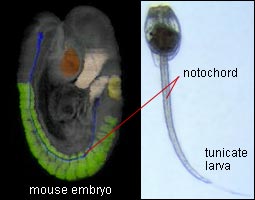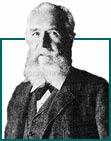
Darwin showed how the mysterious similarities between embryos made ample sense if life evolved by natural selection. With the publication of the Origin of Species, many scientists then asked the next logical question: did embryonic development record the actual evolutionary history of their species?
Initially, the prospects were promising. Some invertebrates known as tunicates or sea squirts, for example, develop the same kind of stiff rod, known as a notochord, that vertebrates form in their back as embryos. In vertebrates the notochord turns into the disks between the vertebrae. Researchers speculated that a sea-squirt-like animal might have been the ancestor of vertebrates. (Recent DNA studies show that sea squirts are in fact the closest known invertebrate relatives of vertebrates.)
Ontogeny recapitulates phylogeny…or does it?
 The evolutionary study of embryos reached a peak in the late 1800s thanks primarily to the efforts of one extraordinarily gifted, though not entirely honest, scientist named Ernst Haeckel (left). Haeckel was a champion of Darwin, but he also embraced the pre-Darwinian notion that life formed a series of successively higher forms, with embryos of higher forms “recapitulating” the lower ones. Haeckel believed that, over the course of time, evolution added new stages to produce new life forms. Thus, embryonic development was actually a record of evolutionary history. The single cell corresponded to amoeba-like ancestors, developing eventually into a sea squirt, a fish, and so on. Haeckel, who was adept at packaging and promoting his ideas, coined both a name for the process — “the Biogenetic Law” — as well as a catchy motto: “Ontogeny recapitulates phylogeny.”
The evolutionary study of embryos reached a peak in the late 1800s thanks primarily to the efforts of one extraordinarily gifted, though not entirely honest, scientist named Ernst Haeckel (left). Haeckel was a champion of Darwin, but he also embraced the pre-Darwinian notion that life formed a series of successively higher forms, with embryos of higher forms “recapitulating” the lower ones. Haeckel believed that, over the course of time, evolution added new stages to produce new life forms. Thus, embryonic development was actually a record of evolutionary history. The single cell corresponded to amoeba-like ancestors, developing eventually into a sea squirt, a fish, and so on. Haeckel, who was adept at packaging and promoting his ideas, coined both a name for the process — “the Biogenetic Law” — as well as a catchy motto: “Ontogeny recapitulates phylogeny.”
Haeckel was so convinced of his Biogenetic Law that he was willing to bend evidence to support it. The truth is that the development of embryos does not fit into the strict progression that Haeckel claimed. Echidnas, for example, develop their limbs much later than most other mammals. But in his illustrations of echidna embryos, Haeckel deceptively omitted limb buds at early stages, despite the fact that limb buds do exist then. In Haeckel’s own day, some biologists recognized his sleights of hand, but nevertheless the Biogenetic Law became very popular, and Haeckel’s illustrations even found their way into biology textbooks.
The biogenetic law is broken
By the turn of the century, scientists had discovered many cases that defied Haeckel’s so-called law. His followers tried to cast them as exceptions that proved the rule. But Haeckel’s final downfall came with the rise of genetics and the modern synthesis. Haeckel, after all, was promoting a basically Lamarckian notion that evolution had a built-in direction towards “higher” forms. But genes, it was soon discovered, controlled the rate and direction of embryonic development. Individual genes can mutate and cause different changes to the way embryos grow — either adding new stages at any point along their path, or taking them away, speeding up development or slowing it down.

Embryos do reflect the course of evolution, but that course is far more intricate and quirky than Haeckel claimed. Different parts of the same embryo can even evolve in different directions. As a result, the Biogenetic Law was abandoned, and its fall freed scientists to appreciate the full range of embryonic changes that evolution can produce — an appreciation that has yielded spectacular results in recent years as scientists have discovered some of the specific genes that control development.
